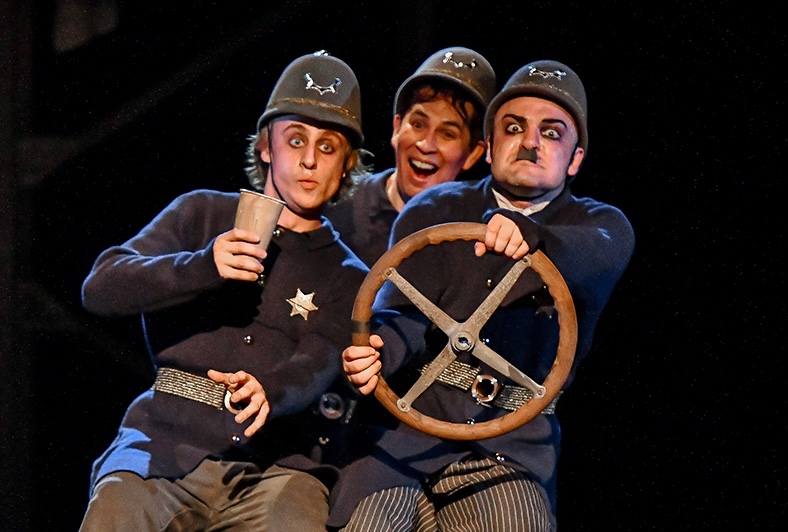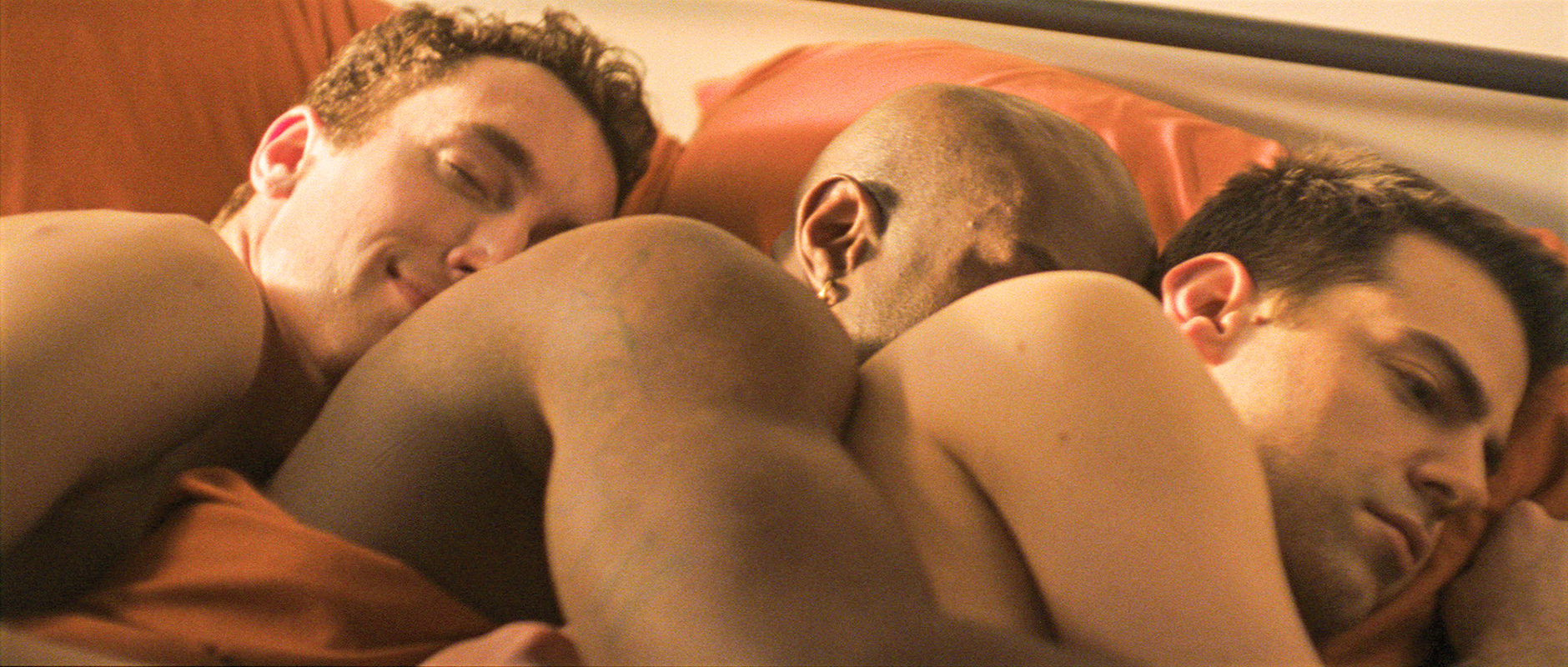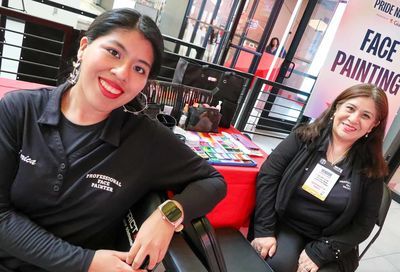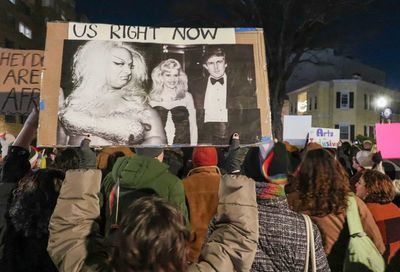‘Nope’ Review: Just Say Yes
Jordan Peele maintains his track record as a master of suspense with the eerie to the extreme 'Nope.'
By André Hereford on July 22, 2022 @here4andre

Some very strange phenomena arise around the quiet, family-run Haywood horse ranch in Nope (★★★★☆), the latest genre-bending feature from Oscar-winning Get Out and Us auteur Jordan Peele.
First, a sudden, lethal downpour rains down on the farm from a peculiar cloud lingering directly above. Voices, screaming in agony, fill the air over the small town of Agua Dulce, California. From there, the film methodically, tantalizingly teases out details of an unexplained presence intent on claiming this remote territory as its own.
The movie opens with a tease, in fact, a harrowing flashback to another sudden, lethal outburst, this time on the set of a ’90s sitcom called Gordy’s Home. We hear, but can see only brief glimpses of the grisly scene as the titular star of the show, a chimpanzee playing “Gordy,” goes on a vicious, bloody rampage that leaves no one standing in that TV studio.
The actual violence doesn’t appear onscreen, just the withering sight of the blood-soaked ape pausing to catch its breath, before pouncing again on a struggling victim that he continues to pound relentlessly. Not only is the visual restraint effective, but the mere sound of flesh and bone being pummeled and torn apart evokes more terror in the imagination than any single onscreen image might accomplish.
Throughout, the film relies on excellent sound design, as much as any visual spectacle, to illustrate the bizarre occurrences at the Haywood ranch. Still, cinematographer Hoyte Van Hoytema (Dunkirk, Interstellar), shooting in IMAX, captures some absolutely arresting tableaux, like one indelible image of blood and carnage raining down on the farmhouse.
Usually, however, it’s the thought of objects and actions unseen that carries the most weight here. Peele is masterful at wielding the power of suggestion, and the art of misdirection, to fuel fear and anticipation. Though, ultimately, anticipation of the mysterious thing hovering over Nope turns out to be more frightening than the thing itself.
But the movie has a field day toying with our anticipation, drawing its characters and the audience into the deepening mystery, weaving disparate genre threads together to depict an epic struggle between the Haywoods and their hostile visitor.
Get Out leading man Daniel Kaluuya, as horse trainer OJ Haywood, who runs Haywood Hollywood Horses with his taciturn dad Otis (Keith David), supplies the steady, determined aura of a decent, hard-working man looking out for his family and their historic horse wrangling business.

Yang to his yin, Keke Palmer plays OJ’s far less responsible little sis, Emerald, the fast-talking, hustling Haywood whose over-the-top reactions to the bizarre goings-on at the ranch are played for solid comedy. The larger personality of the two siblings — and, incidentally, queer — Emerald dominates their interactions the way that Palmer often dominates the screen, through sheer charm and chutzpah.
She’s well-matched in the charm department by Brandon Perea (The OA) in a star-making turn as Angel, a talky tech specialist from the local electronics store where OJ and Emerald buy surveillance equipment to capture visual evidence of the unexplainable.
Capturing the perfect shot on camera becomes a running theme in the movie, which also depicts OJ and Emerald working on the set of a commercial, as well as the aftermath of the terrifying massacre on the set of Gordy’s Home.
In the film’s most intriguing performance, Steven Yeun portrays Ricky “Jupe” Park, a former child actor who survived the Gordy’s Home rampage, and now runs a Wild West theme park in Agua Dulce where danger also lurks. Ricky knows better than anyone how shockingly quickly a pleasant afternoon of fun and make-believe can turn into a ghastly spectacle.
So does Peele. Nope actually references a biblical verse heralding what OJ calls a “bad miracle”: I will cast abominable filth upon you/Make you vile/And make you a spectacle.
Based on the film’s frequent nods to filmmaking, Peele seems keenly aware of audience expectations. So the verse suffices as a horror maker’s mission statement, if not an explanation for the relatively straightforward plot, which seems designed to arouse fear and existential curiosity in equal measure.
Nope is Rated R and is playing in theaters nationwide, including Landmark Theatres. Visit www.landmarktheatres.com.
Synetic Works its Magic on Charlie Chaplin in ‘The Immigrant’
Synetic's magnificently layered riff on Charlie Chaplin and his most iconic character hits close to home.
By Kate Wingfield on March 27, 2025
Like life imitating art and art imitating life, Synetic Theater currently has rather a lot in common with the subject of their production of The Immigrant, a riff on Charlie Chaplin and his tragic-comic character known as the Little Fellow.
Not only are Synetic's founders themselves immigrants, but the company is now as homeless as Chaplin's character. Add the fact that the headlines don't go a day without covering the plight of immigrants of all stripes, and it's all happening here under the bowler hat.
Of course, having no space to call home is no laughing matter -- especially since Synetic must move between area theaters, even mid-run, as in the case of The Immigrant. This must be taking its toll.
In the Gay Film ‘Throuple,’ Three is Most Definitely a Crowd
The gay rom-com "Throuple" dips a toe into non-monogamy with smarts and sensitivity but stays too close to the surface.
By André Hereford on March 22, 2025 @here4andre
It takes two to tango, with good reason -- add one, and the footwork gets way more intricate, to say nothing of where all the other parts go. An adventurous couple and an enthusiastic third try out their footwork, and stumble through the dance, in the Brooklyn-set queer indie Throuple, a notable feature debut for director Greyson Horst.
Michael Doshier wrote the script and stars as perpetually single singer-songwriter Michael, who lives too co-dependently with best friend and fellow musician Tristan (Tristan Carter-Jones). She's getting more and more serious with her girlfriend Abby (Jess Gabor), so, essentially, Michael's already playing third wheel in their relationship.
‘Black Bag’ is a Slam-Bang Thriller from Steven Soderbergh
Steven Soderbergh's spicy spy thriller "Black Bag" comes packed with sharp twists, intrigue, and innuendo.
By André Hereford on March 16, 2025 @here4andre
Most A-list filmmakers in the streaming era would be glad, and lucky, to have one decent feature hit theaters in a year. So, snaps up to Steven Soderbergh, back with his second slam-bang film this season, following up January's nifty haunted house thriller Presence with the wily spy thriller Black Bag.
Soderbergh and Presence screenwriter David Koepp load up the sex, lies, and video files for this taut tale of a search for the snake hiding within a nest of secret agents. The top agent, George Woodhouse, portrayed with cool determination by Michael Fassbender, is tasked with rooting out a mole embedded in a black-ops division of British intelligence. Among his list of suspects is his own wife, Kathryn, played with a sly glint in her eye by a brashly brunette Cate Blanchett.
Support Metro Weekly’s Journalism
These are challenging times for news organizations. And yet it’s crucial we stay active and provide vital resources and information to both our local readers and the world. So won’t you please take a moment and consider supporting Metro Weekly with a membership? For as little as $5 a month, you can help ensure Metro Weekly magazine and MetroWeekly.com remain free, viable resources as we provide the best, most diverse, culturally-resonant LGBTQ coverage in both the D.C. region and around the world. Memberships come with exclusive perks and discounts, your own personal digital delivery of each week’s magazine (and an archive), access to our Member's Lounge when it launches this fall, and exclusive members-only items like Metro Weekly Membership Mugs and Tote Bags! Check out all our membership levels here and please join us today!
The Magazine
-
Most Popular
 Gay Army Reserve Officer in Uniform Sex Video Scandal
Gay Army Reserve Officer in Uniform Sex Video Scandal  Gay Porn Star Tim Kruger Dead at 44
Gay Porn Star Tim Kruger Dead at 44  WorldPride Warns International Trans Visitors About Travel Risks
WorldPride Warns International Trans Visitors About Travel Risks  Charges Dropped in Nancy Mace Assault Case
Charges Dropped in Nancy Mace Assault Case  Awesome Con Gallery: Rage Gear Studios
Awesome Con Gallery: Rage Gear Studios  'Porn Star University' Started by Gay-for-Pay Creator Andy Lee
'Porn Star University' Started by Gay-for-Pay Creator Andy Lee  Greece to Ban Surrogacy for Gay Male Couples
Greece to Ban Surrogacy for Gay Male Couples  Cherry 2025 Wields the Dance Power of the Elements
Cherry 2025 Wields the Dance Power of the Elements  This Week's Advertisers: Rep. Becca Balint - April 10, 2025
This Week's Advertisers: Rep. Becca Balint - April 10, 2025  Trump's FDA Cracks Down on "Poppers"
Trump's FDA Cracks Down on "Poppers"
 This Week's Advertisers: Rep. Becca Balint - April 10, 2025
This Week's Advertisers: Rep. Becca Balint - April 10, 2025  WorldPride Warns International Trans Visitors About Travel Risks
WorldPride Warns International Trans Visitors About Travel Risks  Charges Dropped in Nancy Mace Assault Case
Charges Dropped in Nancy Mace Assault Case  Gay Army Reserve Officer in Uniform Sex Video Scandal
Gay Army Reserve Officer in Uniform Sex Video Scandal  WATCH: Ad Attacks Senator Over Trans Athlete Vote
WATCH: Ad Attacks Senator Over Trans Athlete Vote  John Grant Happily Talks About Everything and Everyone
John Grant Happily Talks About Everything and Everyone  Conversion Therapist Sexually Abused Male Clients
Conversion Therapist Sexually Abused Male Clients  Public Health Nightmare: CDC Shuts STI Lab, Fires Its Scientists
Public Health Nightmare: CDC Shuts STI Lab, Fires Its Scientists  Win Tickets to DeathbyRomy
Win Tickets to DeathbyRomy  Broadway's Grand and Glorious 'Purpose'
Broadway's Grand and Glorious 'Purpose'
Scene
Metro Weekly
Washington's LGBTQ Magazine
P.O. Box 11559
Washington, DC 20008 (202) 638-6830
About Us pageFollow Us:
· Facebook
· Twitter
· Flipboard
· YouTube
· Instagram
· RSS News | RSS SceneArchives
Copyright ©2024 Jansi LLC.









You must be logged in to post a comment.